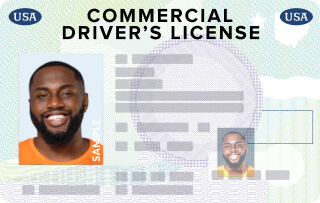- Updated for March 2025
- Based on 2025 NJ commercial driver's license manual
Free NJ CDL Tanker Vehicles Practice Test 2025
So you want to become a tanker truck driver in New Jersey. You’re probably aware of what it takes to obtain a Tank Vehicles (N) endorsement on your Commercial Driver’s License (CDL). There’s a 20-question knowledge test you need to pass before the MVC allows you to operate vehicles designed to transport any liquid or gaseous materials within a tank or tanks having an individual rated capacity of more than 119 gallons and an aggregate rated capacity of 1,000 gallons or more.
You should prepare for this test several weeks in advance, studying liquid cargo handling, liquid surge management, emergency procedures and the pre-trip inspection required before you drive the vehicle. During this time, you’ll explore the fundamentals of commercial driving and its endorsements as explained in the official 2025 CDL manual (New Jersey CDL Handbook 2025).
Since New Jersey offers a wide range of career opportunities for tanker truck drivers, we recommend checking the Hazardous Materials section as well. Refineries in Linden, Perth Amboy, and Bayonne provide plenty of jobs for drivers who hold a CDL with an ”X” endorsement, which consists of the Tank Vehicles (N) and HazMat (H) endorsements pair.
Although the CDL manual provides crucial information for commercial drivers, beginners often find the material too difficult to study. It takes a while to familiarize yourself with this key part of the transportation industry, but studying for your dream career shouldn’t feel like a chore you would prefer to skip. That’s why we provide a series of CDL Tank Vehicles endorsement practice tests specific to the state of New Jersey.
Due to their versatility, you can use them to learn more about this subject. Each practice test comes with a series of features that can significantly enhance your experience and boost your learning journey. After selecting an answer, you will receive immediate feedback consisting of a detailed explanation, so you won’t have to wait until the end of the test to identify and fix your mistakes. And since you get unlimited attempts, don’t be discouraged if you fail. See it as an opportunity to do better and slowly improve your score after each session.
- Perfect for first-time and renewal CDL/CLP applicants, and those adding endorsements
- Triple-checked for accuracy
What you need to know

What to expect on the actual NJ MVC exam
questions
correct answers to pass
passing score
List of questions (classic view)
- Side-to-side surge can cause
- How does liquid surge affect the handling of a tanker?
- Hauling liquids in tankers requires special care for which of the following reasons?
- How would you expect a truck with a cargo tank that has baffles to handle on the road?
- A smooth bore tank is also known as
- Empty trucks
- A tank endorsement is required for certain vehicles that transport
- The best way to take a curve in a tanker is to slow to a safe speed before entering the curve and then _________ as you go through it.
- The liquid in a tank with baffles can still have what kind of surge?
- You should be very cautious when driving smooth bore tankers, especially when you are
- You should know the outage needed for the liquids you carry because
- When you load the small tanks of a cargo tank equipped with bulkheads, you should check the
- A baffled tanker is one with
- You are driving on a clear night. You must dim your headlights from high to low. You should adjust your speed so you can stop within
- When your cargo tank has baffles, what handling effect do you expect?
- The movement of the liquid in partially filled tanks is called
- When should the driver of a tanker that has lost its brakes use a truck escape ramp?
- You are driving a tanker truck. The front wheels begin to skid. Which of these is most likely to occur?
- An emergency forces you to stop your tanker quickly or crash. You should
- Which of these statements about tankers are true?
- Alabama: Test 1 / Test 2
- Alaska: Test 1 / Test 2
- Arizona: Test 1 / Test 2
- Arkansas: Test 1 / Test 2
- California: Test 1 / Test 2
- Colorado: Test 1 / Test 2
- Connecticut: Test 1 / Test 2
- Delaware: Test 1 / Test 2
- District of Columbia: Test 1 / Test 2
- Florida: Test 1 / Test 2
- Georgia: Test 1 / Test 2
- Hawaii: Test 1 / Test 2
- Idaho: Test 1 / Test 2
- Illinois: Test 1 / Test 2
- Indiana: Test 1 / Test 2
- Iowa: Test 1 / Test 2
- Kansas: Test 1 / Test 2
- Kentucky: Test 1 / Test 2
- Louisiana: Test 1 / Test 2
- Maine: Test 1 / Test 2
- Maryland: Test 1 / Test 2
- Massachusetts: Test 1 / Test 2
- Michigan: Test 1 / Test 2
- Minnesota: Test 1 / Test 2
- Mississippi: Test 1 / Test 2
- Missouri: Test 1 / Test 2
- Montana: Test 1 / Test 2
- Nebraska: Test 1 / Test 2
- Nevada: Test 1 / Test 2
- New Hampshire: Test 1 / Test 2
- New Jersey: Test 1 / Test 2
- New Mexico: Test 1 / Test 2
- New York: Test 1 / Test 2
- North Carolina: Test 1 / Test 2
- North Dakota: Test 1 / Test 2
- Ohio: Test 1 / Test 2
- Oklahoma: Test 1 / Test 2
- Oregon: Test 1 / Test 2
- Pennsylvania: Test 1 / Test 2
- Rhode Island: Test 1 / Test 2
- South Carolina: Test 1 / Test 2
- South Dakota: Test 1 / Test 2
- Tennessee: Test 1 / Test 2
- Texas: Test 1 / Test 2
- Utah: Test 1 / Test 2
- Vermont: Test 1 / Test 2
- Virginia: Test 1 / Test 2
- Washington: Test 1 / Test 2
- West Virginia: Test 1 / Test 2
- Wisconsin: Test 1 / Test 2
- Wyoming: Test 1 / Test 2
Your go-to, trusted source
Experience the Driving-Tests differenceOur commitment to accuracy and quality in our practice tests
Explore our rigorous, multi-tiered verification process that ensures each question mirrors the official manual for unparalleled accuracy.

At Driving-Tests.org, we understand the importance of reliable and accurate practice tests to help you prepare for your DMV exam. That's why we've developed a meticulous process to create and continually update our practice questions, ensuring they reflect the most current driving laws and regulations.
Here's an inside look at how we maintain the highest quality in our practice tests.
Content Creation and Verification Process
- Alignment with Official Manuals:
Every question we develop is based on the most recent version of each state's official driving manual. Our team regularly monitors each state DMV's website for the latest updates to ensure our practice tests are always aligned with the most current information. - Community Feedback Integration:
We leverage feedback from our vast community of users to understand which topics are most frequently tested. This helps us focus on the areas that are most relevant and beneficial for your preparation. - Expert Content Creation:
Our in-house editor, Steven, who has extensive experience in driver education, crafts each question with precision. He conducts a thorough review of each question against the official manuals to ensure accuracy. - Rigorous Review Process:
Once Steven has finalized a set of questions, our team conducts a joint review session. This second level of scrutiny involves content accuracy, proofreading, and fact-checking to eliminate any errors. - User Feedback Mechanism:
After a question goes live on our site, we keep the lines of communication open. Each question features a feedback button, inviting users to report any issues or errors. This continuous feedback loop allows us to address and rectify any concerns promptly. - Responsive Updates:
In line with our commitment to accuracy, we quickly update our practice questions to reflect any changes in the DMV manuals. Additionally, we update the free electronic copy of the state's driver's license manuals on our site, typically within a few days after the DMV publishes them.
Our thorough quality control process ensures that you have access to practice tests that are as accurate and up-to-date as possible. We believe in the power of well-prepared drivers and are dedicated to providing you with the best study tools to help you succeed on your DMV exam.
Pass the First Time – Guaranteed
You’re moments away from your results.
Before you view them, see how 1.15 million drivers used Premium to pass faster.
Real Exam-Like New Jersey Questions
Get all exam-like questions seen on the real test.
99.06% Pass Rate vs. 49% Average
Most Premium users pass on their first try.
Money-Back Guarantee
We stand behind you until you pass.




